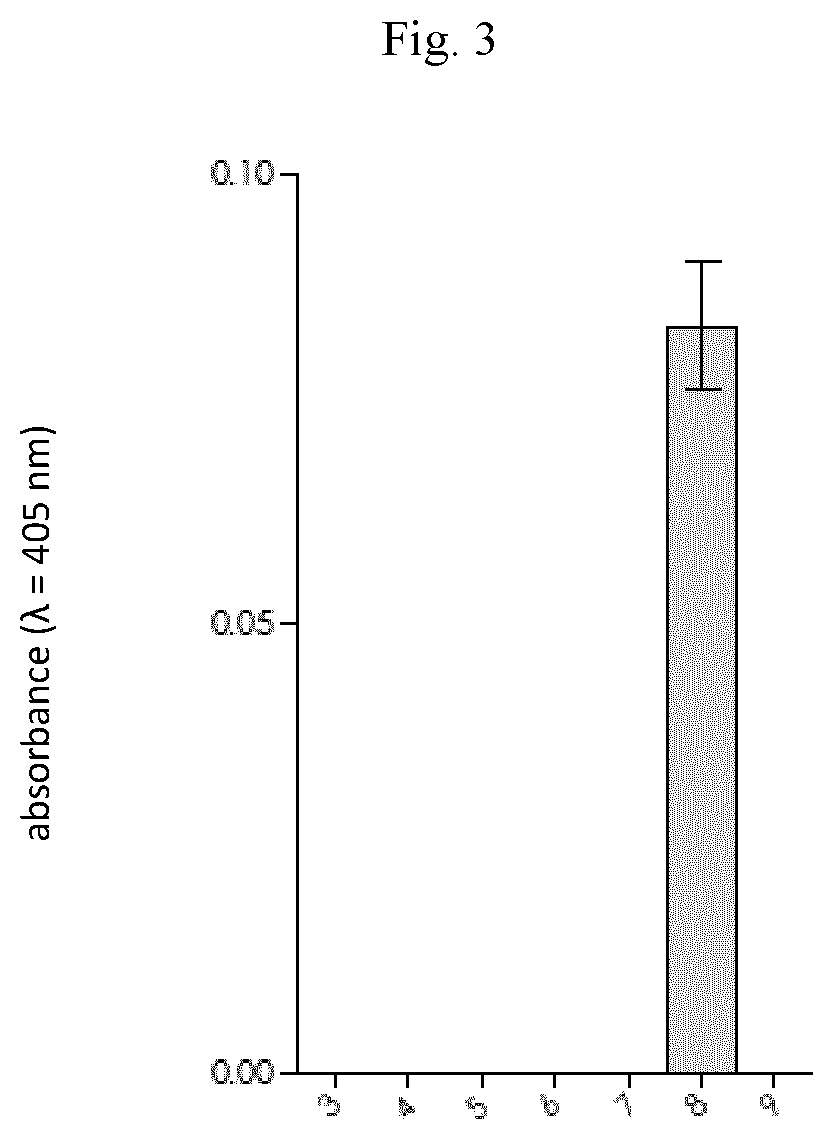Novel diagnostic marker for pancreatic cancer
a pancreatic cancer and diagnostic marker technology, applied in the field of new diagnostic markers for pancreatic cancer, can solve the problems of poor prognosis of pancreatic cancer and the death of the vast majority of cases, and achieve the effect of increasing the risk and increasing the activity of proteas
- Summary
- Abstract
- Description
- Claims
- Application Information
AI Technical Summary
Benefits of technology
Problems solved by technology
Method used
Image
Examples
example 1
Synthesis of compound ABZ1-Thr2-Thr3-Ala4-Argy-ANB-NH26
[0116]1. Preparation of the Chromogenic Peptide[0117]a) The first stage of the synthesis was to obtain a chromogenic peptide by solid phase synthesis—on a solid support, using Fmoc / tBu chemistry, i.e. using the protection. A compound with the sequence ABZ1-Thr2-Thr3-Ala4-Arg5-ANB-NH26, where ABZ is 2-aminobenzoic acid, ANB-NH2 is amide of 5-amino-2-benzoic acid, and ANB is 5-amino-2-benzoic acid, obtained in the process of chemical synthesis in the solid phase using the following amino acid derivatives.[0118]Boc-ABZ, Fmoc-Thr(tBu), Fmoc-Ala, Fmoc-Arg(Pbf), ANB[0119]The synthesis of the compound, i.e. a diagnostic marker for the detection of pancreatic cancer, whose diagnosis is associated with the hydrolysis of this compound under the influence of proteolytic enzymes, was carried out on a solid support enabling the conversion of 5-amino-2-benzoic acid into ANB-NH2 amide:[0120]—e.g. amide resin, for instance TentaGel S RAM from ...
example 2
Preparation of the Compound With the formula: ABZ1-Thr2-Thr3-Ala4-Arg5-pNA6
[0191]The process is carried out in a similar manner to that described in Example 1, except that the corresponding amino acid derivatives and additional substituents are used, and the process is carried out partly in solution and partly on a solid support.
[0192]Preparation of p-nitroanilide Ala[0193]a) The first stage of the synthesis was to obtain a protected peptide by solid phase synthesis using Fmoc / tBu chemistry.[0194]ABZ1-Thr(tBu)2-Thr(tBu)3-Ala4-OH compound, where ABZ is 2-aminobenzoic acid, was obtained by solid phase chemical synthesis using the following amino acid derivatives:[0195]Boc-ABZ, Fmoc-Thr(tBu), Fmoc-Ala.[0196]The compound was synthesized on a solid support:[0197]2-chloro-chlorotriyl resin, e.g. from Iris BIOTECH GMBH (Germany), with deposition of 1.6 mmol Cl / g groups.[0198]The compound was synthesized manually using a laboratory shaker. Throughout all stages, a 25 ml sintered syringe for...
example 3
[0257]The study on the application of new compounds was performed on a group of 10 patients diagnosed with pancreatic cancer. For this purpose, the compound with formula 2: ABZ-Thr-Thr-Ala-Arg-ANB-NH2 or formula 3: ABZ-Thr-Thr-Ala-Arg-pNA was dissolved in dimethyl sulfoxide (at a concentration of 0.5 mg / mL); 50 μL of this solution was mixed with 120 μl buffer (200 mM Tris-HCl, pH 8.0) and 80 μL of urine of a person with pancreatic cancer. The measurement was made in a 96-well plate designed for measuring absorbance, and each sample was analysed in triplicate at 37° C. The duration of the measurement was 60 minutes. During the measurement, the wavelength characteristic of the released chromophore (ANB-NH2 or pNA) was monitored at 405 nm (range 380-430 nm).
[0258]As a result of the measurement, the colour of the solution increased over time in all urine samples from patients diagnosed with pancreatic cancer. The observed absorbance increase over time was different for each of the teste...
PUM
| Property | Measurement | Unit |
|---|---|---|
| fluorescence | aaaaa | aaaaa |
| absorbance | aaaaa | aaaaa |
| absorbance intensity | aaaaa | aaaaa |
Abstract
Description
Claims
Application Information
 Login to View More
Login to View More - R&D
- Intellectual Property
- Life Sciences
- Materials
- Tech Scout
- Unparalleled Data Quality
- Higher Quality Content
- 60% Fewer Hallucinations
Browse by: Latest US Patents, China's latest patents, Technical Efficacy Thesaurus, Application Domain, Technology Topic, Popular Technical Reports.
© 2025 PatSnap. All rights reserved.Legal|Privacy policy|Modern Slavery Act Transparency Statement|Sitemap|About US| Contact US: help@patsnap.com



